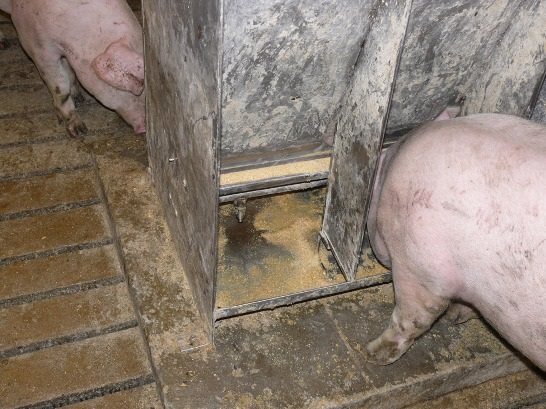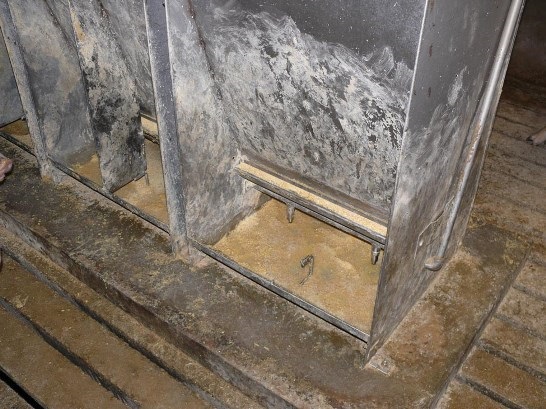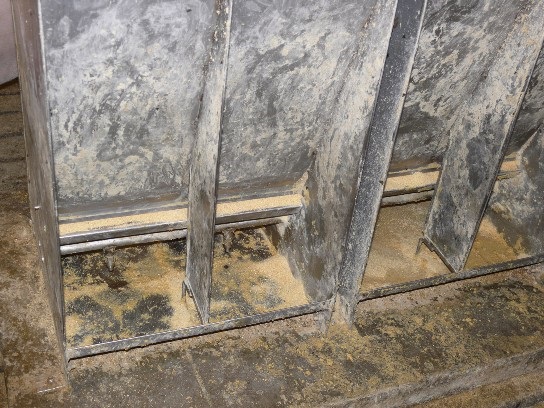Feeder management in the grower-finisher barn
Learn the importance of timely feeder management and maintenance of feeding systems in a grower-finisher operation.
ISSN 1198-712X, Published June 2012
Timely feeder management and maintenance of feeding systems can reduce feed costs – the largest expense of a grower-finisher operation. On most farms, feed cost can range from 65%–75% of the total cost to produce a grower-finisher pig to market weight. It only makes sense to continually look for ways to optimize the use and performance of your most expensive input.
Estimates suggest that 2%–20% of feed on swine farms is wasted
Table 1 gives examples of the feed cost per pig as percentage of feed waste increases.
| Percentage of feed waste | Feed for 93-kg gain | Cost/pig feed | Cost/pig waste | Feed conversion |
|---|---|---|---|---|
| 0% | 260 | $82.34 | $0.00 | 2.80 |
| 2% | 266 | $83.99 | $1.65 | 2.86 |
| 4% | 271 | $85.63 | $3.29 | 2.91 |
| 6% | 276 | $87.28 | $4.94 | 2.97 |
| 8% | 281 | $88.93 | $6.59 | 3.02 |
| 10% | 286 | $90.57 | $8.23 | 3.08 |
| 15% | 299 | $94.69 | $12.35 | 3.22 |
| 20% | 312 | $98.81 | $16.47 | 3.36 |
Assumptions:
- Gain from 27 kg to 120 kg
- Average feed cost of $0.3162/kg
Source: OMAFRA Swine Budget January – June 2011
Feeder space
The first step in improving feeder management is to determine how many pigs the feeder can handle efficiently. This will depend on the feeder design, type of feed used and location of the water. Raising pigs to heavier weights may require reducing the number of pigs for each feeder or pen. Studies have shown that a reduction in feed efficiency may be caused by pen overcrowding rather than reduced access to feeders. Larger pigs (120+ kg) will require more shoulder space at the feeder (Figure 1), which may result in a four-hole feeder only accommodating three heavier pigs. The capacity of a feeder will depend on its design and whether feed is a mash or a pellet. Refer to the manufacturer's recommendations for information on feeder capacity and set-up.
Feed waste
Feed costs are the largest part of a farm's expenses, so reducing feed waste pays off. Check your feed system from bin through to feeder thoroughly. Look for signs of spillage, leaks and loose connections, and make repairs as needed. Spilt feed may attract rodents or birds, which can cause health problems and spoil feed.
Look for feeders in need of repair or replacement (Figure 2). On slatted floors, check the pits below the front of feeders for signs of spillage, then fix or adjust feeders accordingly (Figure 3).
Checking feeders daily limits the amount of stale, spoiled or mouldy feed that accumulates. Monitor feed waste in pens where market hogs are being shipped; as pig numbers decline, adjust feeders to reduce feed waste. For ways to reduce feed waste, see Dry Feeders and Wet/Dry Feeders.
Adjust feeders as pigs grow, to accommodate their changing size and ration needs (Figure 4).
Dry feeders
Check dry feeders regularly for blockage, spoiled/wet feed or bridging. Feed should flow evenly into all feeder compartments.
In a dry feeder, the gap between the agitation plate and the trough floor will determine the amount of feed that can flow into the feeder. A feeder gap that is too narrow can restrict the amount the pig may eat and in some cases cause the feeder to plug. One plugged feeder space in a four-hole feeder can easily be overlooked. But when the whole feeder becomes plugged, the end result can mean more days to market for the pig and increased costs to the producer. On the other hand, having the feeder gap too large will prevent plugging but results in feed waste and increased feed cost.
Check the bottom pan of feeders to make sure they are adjusted properly. No one adjustment fits all. Kansas State University swine research suggests that 40%–50% of the feeder pan floor be covered for grower-finisher pigs. Adjust feeders to allow feed to cover slightly more than half of the feed pan without it accumulating in the corners
Further research has shown that for finisher pigs at 41 kg, a feeder gap setting of at least 1.9 cm results in approximately 58% pan coverage, maximizing gain without affecting feed efficiency. However, after pigs reach 68 kg, a 1.27-cm gap width results in approximately 28% pan coverage, minimizing feed waste and optimizing both average daily gain (ADG) and feed-to-gain ratio (F:G). Optimum feeder gap settings differ with each growth phase
Keep dry feeders in good working order by making these steps a routine
- Close feeder completely after cleaning and before putting any feed in the feeder.
- Open feeder just enough to start small feed flow.
- Shake feeder to increase the amount of pellets or meal in the pan (to cover half of pan).
- Clean corners daily instead of increasing feeder adjustment to increase feed flow.
- Prevent moisture damage and spoilage in feed systems and storage through proper maintenance.
- Eliminate all rodents, birds and other pests.
Wet/dry feeders
Studies have shown that feeders having within-feeder water access can service more pigs than dry feeders of the same feeder space. Mash diets, using a wet/dry feeder, will increase feed intake by 5% compared to dry feeders
Water access
Do not restrict access to water or take water for granted. Properly working water nipples/bowls are a must for maximizing pig growth. Set the water nipples at mid-shoulder height or slightly higher, and adjust as the pig grows
Ensure there is enough water for the number of animals in the pen. Not enough water can cause problems. The older pig is an impatient drinker. With too slow a rate, pigs become more aggressive, and the pigs at the lower end of the social hierarchy may have less chance to drink. A pig that drinks less, eats less and gains slower
Check the flow rates on all nipples regularly (once a week and before introducing new animals to a pen or barn). The flow rate is 0.7–1 L/min for finisher pigs
Overcrowding
Raising pigs to heavier weights may require fewer pigs per pen to prevent overcrowding. The pigs should all be able to lie down and still have walking space to the feeder, water and manure area without trampling others. If pigs are being challenged to get to feed or water, the days to market will increase. Crowding pigs in the finisher barn can lead to a 10% decline in growth rate
Feed spoilage
Try to determine the causes of feed spoilage, including too much flow of feed, water leaking in trough, feeder trough in need of repair, poor feeder location or ventilation problems. Check feeders daily for signs of feed blockage, spoilage and waste.
Electronics (switches and alarms)
Check proximity switches that run automated feed systems to make sure they are working and are set properly. Check that your safety switches and alarms are working. Keep a record of when safety switches and alarms were tested and by whom. Testing these the day after a major feed spill, or an out-of-feed event, is not considered a good test, but usually results in the problem being fixed.
Out-of-feed events
Out-of-feed events come in all forms and at all times, including feed bridging in grain bins, empty feed bins, feed augers plugging and equipment breakdowns. Research has shown that the pig's age and amount of time out of feed will determine the economic loss, but the pig's welfare, performance and productivity can suffer, regardless of age
Summary
Proper feeder management can help reduce feed waste and feed costs, improving your operation's bottom line. If your current management strategy relies on seeing pigs eat or having feed in the trough, your feeder could be costing your operation real dollars. Take the time to review your feeder management. Even a few small changes can save money.
Footnotes
- footnote[1] Back to paragraph Schell, T., E. van Heugten, A. Harper. 2006. Managing Feed Waste. www.porkgateway.org.
- footnote[2] Back to paragraph Gonyou, H.W., and Z. Lou. 1998. Grower/Finisher Feeders: Design, behaviour and performance. Prairie Swine Centre, Inc., Saskatoon. Monograph, 97-01. p. 17.
- footnote[3] Back to paragraph Gonyou, H.W. 1999. Feeder and Pen Design to Increase Efficiency. Advances in Pork Production, Volume 10, p. 106.
- footnote[4] Back to paragraph Duttlinger A.W., S.S. Dritz, M.D. Tokach, J.M. DeRouchey, J.L. Nelssen, and R.D. Goodband. 2008. Effects of Feeder Adjustment on Growth Performance of Growing and Finishing Pigs. Kansas State Swine Day.
- footnote[5] Back to paragraph Myers A.J., R.D. Goodband, M.D. Tokach, S.S. Dritz, J.R. Bergstrom, J.M. DeRouchey, and J.L. Nelssen. 2010. The Effects of Feeder Adjustment on Growth Performance of Finishing Pigs. Kansas State Swine Day.
- footnote[6] Back to paragraph Steps to Proper Feeder Adjustment. Kansas State Swine Extension.
- footnote[7] Back to paragraph Gonyou, H.W., and Z. Lou. Effects of eating space and availability of water in feeders on productivity and eating. J Anim Sci. 2000. 78:865–870.
- footnote[8] Back to paragraph Bergstrom J.R., M.D. Tokach, S.S. Dritz, J.L. Nelssen, J.M. DeRouchey, and R.D. Goodband. 2010. Effects of Feeder Design, Wet-Dry Feeder Adjustment Strategy, and Diet Type on the Growth Performance and Carcass Characteristics of Growing-Finishing Pigs. Kansas State Swine Day.
- footnote[9] Back to paragraph Meyer, Vernon M. 2008. Nipple Waters for Swine. Iowa State Extension.
- footnote[10] Back to paragraph Brumm, M. 2008. Water Recommendations and Systems for Swine. www.usporkcenter.org.
- footnote[11] Back to paragraph Carr J. 2008. Feed Cannot Be Wasted on Pig Farms. The Pig Journal Proceedings, Supplement 1. April 2008.
- footnote[12] Back to paragraph Prairie Swine Center. 2009. Feed and Water Check List.
- footnote[13] Back to paragraph Brumm M., B. Richert, J. Marchant-Forde, R. Marchant. 2005. Out-of-Feed Events in Grow-Finish Pigs: Causes and consequences. Nebraska Swine Reports.



